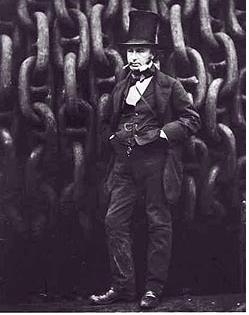Brunel, Isambard Kingdom
Isambard Kingdom Brunel (1809-1859), the great English engineer, is famous for his design and construction of bridges, tunnels, railways, and the steamship. While apprenticing for his father at the age of 20, he supervised the digging of the Rotherhithe Tunnel, the first tunnel to travel under the River Thames. Brunel was instrumental in planning the expansion of the Great Western Railway that dramatically improved transportation among England’s bourgeoning industrial centers. Brunel also revolutionized the design of ocean-going ships, creating ships different than any built before him. In 1838, he built a paddle steamer called the Great Western, the first transatlantic passenger steamship used for regular service. The Great Eastern, completed in 1863, was designed to make a round trip to Australia, going past the Cape of Good Hope, without being re-coaled. The ship also laid the first transatlantic cable. Brunel's ships employed a mix of sails and engines. On days when there was no wind, the ships were powered by engines, but on windy days, the engines could be turned off to save the amount of fuel used and the ships relied solely on the sails for power. Brunel also built or improved already-existing harbors and docks at Bristol, Cardiff, and Milford Haven, UK, and designed prefabricated hospitals for use in the Crimean War. For these and other accomplishments, Brunel is considered a fundamental player in Britain's entry into the steam age.
Further Reading
Historic Figures: Isambard Kingdom Brunel (bbc.co.uk)
History: Isambard Kingdom Brunel (Brunel University)
